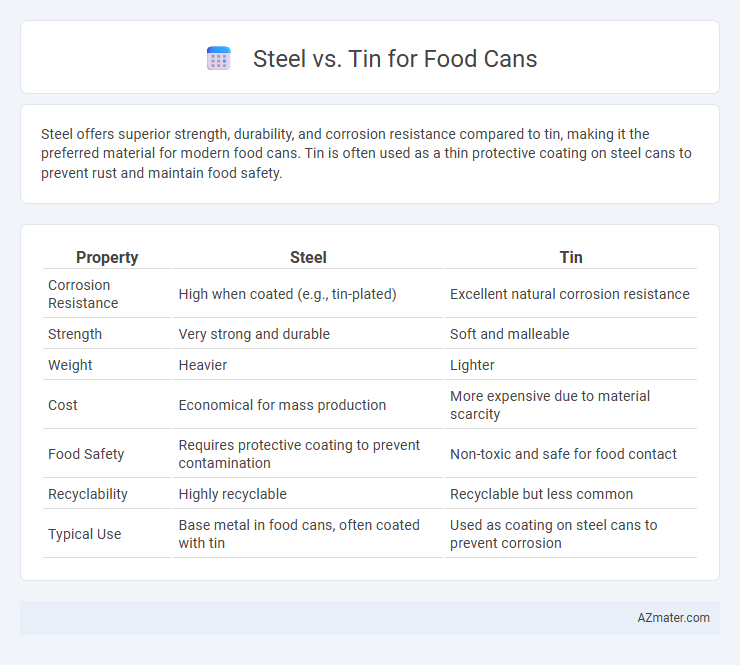Steel offers superior strength, durability, and corrosion resistance compared to tin, making it the preferred material for modern food cans. Tin is often used as a thin protective coating on steel cans to prevent rust and maintain food safety.
Table of Comparison
| Property | Steel | Tin |
|---|---|---|
| Corrosion Resistance | High when coated (e.g., tin-plated) | Excellent natural corrosion resistance |
| Strength | Very strong and durable | Soft and malleable |
| Weight | Heavier | Lighter |
| Cost | Economical for mass production | More expensive due to material scarcity |
| Food Safety | Requires protective coating to prevent contamination | Non-toxic and safe for food contact |
| Recyclability | Highly recyclable | Recyclable but less common |
| Typical Use | Base metal in food cans, often coated with tin | Used as coating on steel cans to prevent corrosion |
Introduction to Food Can Materials
Steel and tin are fundamental materials used in food can manufacturing due to their durability and corrosion resistance. Steel provides structural strength and is often coated with a thin layer of tin to prevent rusting and preserve food quality. This combination ensures food safety, extends shelf life, and maintains the can's integrity during transportation and storage.
Overview of Steel and Tin Construction
Steel food cans are primarily made from tinplate or tin-free steel, featuring a sturdy iron core coated with a thin layer of tin or chromium to prevent corrosion and ensure food safety. Tin coatings provide excellent corrosion resistance and prevent chemical reactions between the steel and food, while tin-free steel cans use chromium or chromium oxide coatings to achieve similar protection with reduced material costs and weight. Both construction methods offer durability and preserve food quality, with tinplate commonly used for acidic foods and tin-free steel preferred for dry or less reactive products.
Strength and Durability Comparison
Steel cans provide superior strength and resistance to impact compared to tin, ensuring better protection for food products during transportation and storage. While tin offers excellent corrosion resistance, steel's enhanced durability and rigidity prevent deformation and maintain structural integrity under pressure. The combination of steel's robust mechanical properties and tin's protective coating results in a balanced solution for food can manufacturing, prioritizing longevity and product safety.
Corrosion Resistance in Steel vs Tin Cans
Steel cans typically have a higher corrosion resistance when coated with tin, known as tinplate, which forms a protective barrier preventing rust and metal contamination in food storage. Tin coatings prevent direct contact between steel and food, significantly reducing oxidation and extending shelf life. However, uncoated steel is prone to corrosion, whereas tin cans inherently resist rust due to the chemical stability of tin on the surface.
Cost Analysis: Steel vs Tin
Steel cans generally offer lower production costs compared to tin due to the abundance and lower price of raw steel materials. Tin plating adds an extra layer of corrosion resistance but increases the cost significantly, making tin-coated cans more expensive in terms of both material and manufacturing expenses. Cost analysis favors steel for bulk food packaging, while tin remains preferred for premium or specialty food products requiring enhanced preservation.
Safety and Food Preservation Capabilities
Steel cans, often coated with a thin layer of tin, provide robust protection against contamination and physical damage, ensuring food safety by preventing external pollutants from entering. Tin's natural corrosion resistance enhances the steel can's ability to preserve food by preventing rust and chemical reactions that could spoil the contents or leach harmful substances. The combination of steel's strength and tin's food-safe properties ensures long-term freshness and safety, making steel-tin cans a preferred choice in food packaging.
Environmental Impact and Recyclability
Steel food cans have a lower environmental impact due to their high recyclability rate, with steel being infinitely recyclable without loss of quality, reducing the need for virgin raw materials and lowering carbon emissions. Tin-plated steel cans, often used for corrosion resistance, contain only a thin layer of tin, which does not significantly affect recyclability but introduces minor environmental concerns related to tin mining and refining. Steel cans dominate recycling streams globally, with established infrastructure that supports circular material use, making them a more sustainable choice compared to other metal packaging options.
Common Applications in the Food Industry
Steel cans coated with tin are widely used for packaging a variety of food products such as canned vegetables, fruits, soups, and meats due to their durability and excellent protection against contamination and corrosion. Tin coating on steel prevents rust and extends the shelf life of canned goods, making it ideal for long-term storage and transportation in the food industry. Common applications include preserving acidic foods, ready-to-eat meals, and beverages, where maintaining food safety and quality is critical.
Consumer Preferences and Market Trends
Steel remains the preferred material for food cans due to its durability, recyclability, and cost-effectiveness, aligning with growing consumer demand for sustainable packaging. Consumer trends show an increasing preference for eco-friendly options, boosting steel's appeal as it is highly recyclable and often contains recycled content. Market analysis indicates that while tin-coated steel offers corrosion resistance and extends shelf life, steel's versatility and strong supply chain support solidify its dominance in the food can industry.
Conclusion: Choosing Between Steel and Tin Cans
Selecting between steel and tin cans depends on factors like corrosion resistance, cost, and food preservation needs; steel cans offer superior strength and are more cost-effective, while tin-coated cans provide enhanced corrosion resistance and longer shelf life. For acidic or moisture-rich foods, tin-plated cans reduce the risk of metal leaching, ensuring safety and quality. Evaluating product type and storage conditions is essential to optimize packaging performance and maintain food integrity.

Infographic: Steel vs Tin for Food Can
 azmater.com
azmater.com